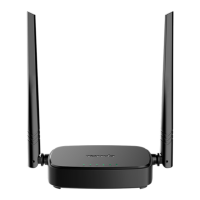Document Version: V1.1
105
Used to enable or disable the DHCP server. Once enabled, the DHCP server
automatically assigns internet parameters such as IP address, subnet mask and
gateway address to the terminal device. This function is recommended to be enabled.
Specifies the range of IP addresses that can be assigned to devices connected to the
router. The default range is 192.168.0.100 to 192.168.0.200.
It is available only when DHCP Server is enabled.
Specifies the valid duration of the IP address that is assigned to a client.
When the lease time reaches half, the client will send a DHCP Request to the DHCP
server for renewal. If the renewal succeeds, the lease is renewed based on the time of
the renewal application. If the renewal fails, the renewal process is repeated again at
7/8 of the lease period. If it succeeds, the lease is renewed based on the time of the
renewal application. If it still fails, the client needs to reapply for IP address
information after the lease expires.
The default value is recommended.
It is available only when DHCP Server is enabled.
Specifies whether to allocate another DNS address to the client. When it is disabled,
the LAN port IP address of the router is used as the DNS address of the client. When it
is enabled, Primary DNS Server must be set and Secondary DNS Server is optional.
‒ It is available only when DHCP Server is enabled.
‒ This router has the DNS proxy function.
Specifies the primary DNS address of the router, which is assigned to the clients. You
can change it if necessary. Make sure that the primary DNS server is the IP address of
the correct DNS server or DNS proxy. Otherwise, you may fail to access the internet.
It is available only when DNS Settings is enabled.
Specifies the secondary DNS address of the router used to assign to the clients. It is an
optional field and is left blank by default.
It is available only when DNS Settings is enabled.

